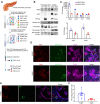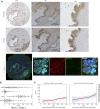Nuclear GSK-3β and Oncogenic KRas Lead to the Retention of Pancreatic Ductal Progenitor Cells Phenotypically Similar to Those Seen in IPMN
- PMID: 35646902
- PMCID: PMC9136019
- DOI: 10.3389/fcell.2022.853003
Nuclear GSK-3β and Oncogenic KRas Lead to the Retention of Pancreatic Ductal Progenitor Cells Phenotypically Similar to Those Seen in IPMN
Abstract
Glycogen synthase kinase-3β (GSK-3β) is a downstream target of oncogenic KRas and can accumulate in the nucleus in pancreatic ductal adenocarcinoma (PDA). To determine the interplay between oncogenic KRas and nuclear GSK-3β in PDA development, we generated Lox-STOP-Lox (LSL) nuclear-targeted GSK-3β animals and crossed them with LSL-KRasG12D mice under the control of the Pdx1-cre transgene-referred to as KNGC. Interestingly, 4-week-old KNGC animals show a profound loss of acinar cells, the expansion of ductal cells, and the rapid development of cystic-like lesions reminiscent of intraductal papillary mucinous neoplasm (IPMN). RNA-sequencing identified the expression of several ductal cell lineage genes including AQP5. Significantly, the Aqp5+ ductal cell pool was proliferative, phenotypically distinct from quiescent pancreatic ductal cells, and deletion of AQP5 limited expansion of the ductal pool. Aqp5 is also highly expressed in human IPMN along with GSK-3β highlighting the putative role of Aqp5+ ductal cells in human preneoplastic lesion development. Altogether, these data identify nGSK-3β and KRasG12D as an important signaling node promoting the retention of pancreatic ductal progenitor cells, which could be used to further characterize pancreatic ductal development as well as lineage biomarkers related to IPMN and PDA.
Keywords: AQP5; GSK-3β; KRAS; intraductal papillary mucinous neoplasm; pancreatic adenocarcinoma; progenitor cell.
Copyright © 2022 Ding, Roeck, Zhang, Zidek, Rodman, Hernandez-Barco, Zhang, Bamlet, Oberg, Zhang, Bardeesy, Li and Billadeau.
Conflict of interest statement
The authors declare that the research was conducted in the absence of any commercial or financial relationships that could be construed as a potential conflict of interest.
Figures






Similar articles
-
Loss of Activin Receptor Type 1B Accelerates Development of Intraductal Papillary Mucinous Neoplasms in Mice With Activated KRAS.Gastroenterology. 2016 Jan;150(1):218-228.e12. doi: 10.1053/j.gastro.2015.09.013. Epub 2015 Sep 25. Gastroenterology. 2016. PMID: 26408346 Free PMC article.
-
GNAS(R201H) and Kras(G12D) cooperate to promote murine pancreatic tumorigenesis recapitulating human intraductal papillary mucinous neoplasm.Oncogene. 2016 May 5;35(18):2407-12. doi: 10.1038/onc.2015.294. Epub 2015 Aug 10. Oncogene. 2016. PMID: 26257060
-
Molecular mechanism of intraductal papillary mucinous neoplasm and intraductal papillary mucinous neoplasm-derived pancreatic ductal adenocarcinoma.J Hepatobiliary Pancreat Sci. 2015 Jul;22(7):519-23. doi: 10.1002/jhbp.246. Epub 2015 Apr 21. J Hepatobiliary Pancreat Sci. 2015. PMID: 25900667 Review.
-
Kras and Lkb1 mutations synergistically induce intraductal papillary mucinous neoplasm derived from pancreatic duct cells.Gut. 2020 Apr;69(4):704-714. doi: 10.1136/gutjnl-2018-318059. Epub 2019 Jun 1. Gut. 2020. PMID: 31154393
-
Glycogen synthase kinase-3β: a novel therapeutic target for pancreatic cancer.Expert Opin Ther Targets. 2020 May;24(5):417-426. doi: 10.1080/14728222.2020.1743681. Epub 2020 Mar 21. Expert Opin Ther Targets. 2020. PMID: 32178549 Free PMC article. Review.
Cited by
-
Metabolic reprogramming by mutant GNAS creates an actionable dependency in intraductal papillary mucinous neoplasms of the pancreas.Gut. 2024 Dec 10;74(1):75-88. doi: 10.1136/gutjnl-2024-332412. Gut. 2024. PMID: 39277181 Free PMC article.
-
Modern aspects of the management of pancreatic intraductal papillary mucinous neoplasms: a narrative review.Rom J Morphol Embryol. 2022 Jul-Sep;63(3):491-502. doi: 10.47162/RJME.63.3.03. Rom J Morphol Embryol. 2022. PMID: 36588487 Free PMC article. Review.
-
Glycogen Synthase Kinase 3β: A True Foe in Pancreatic Cancer.Int J Mol Sci. 2022 Nov 16;23(22):14133. doi: 10.3390/ijms232214133. Int J Mol Sci. 2022. PMID: 36430630 Free PMC article. Review.
References
-
- American Cancer Society (2019). Cancer Facts & Figures 2019. Atlanta: American Cancer Society.
-
- Auciello F. R., Bulusu V., Oon C., Tait-Mulder J., Berry M., Bhattacharyya S., et al. (2019). A Stromal Lysolipid-Autotaxin Signaling Axis Promotes Pancreatic Tumor Progression. Cancer Discov. 9, 617–627. 10.1158/2159-8290.cd-18-1212 - DOI - PMC - PubMed
Grants and funding
LinkOut - more resources
Full Text Sources
Molecular Biology Databases
Miscellaneous

